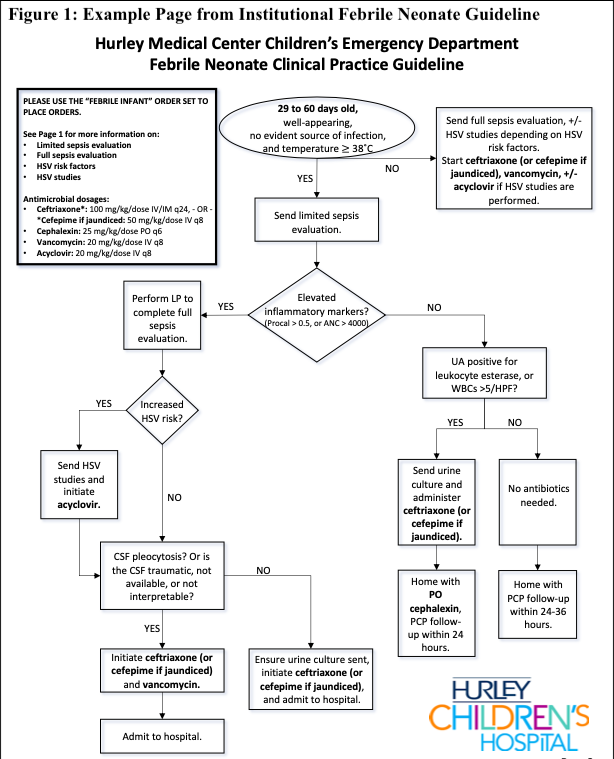Emergency Medicine 3
Session: Emergency Medicine 3
439 - Effect of an Institution-Specific Guideline on Adherence to AAP Guidelines for Febrile Neonates at a Community Hospital
Friday, April 25, 2025
5:30pm - 7:45pm HST
Publication Number: 439.4659
Alisha Ching, University of Michigan Medical School, Ann Arbor, MI, United States; Courtney W.. Mangus, C.S. Mott Children's Hospital, Ann Arbor, MI, United States; Allison Cator, University of Michigan, Ann Arbor, MI, United States; Michele Carney, C.S. Mott Children's Hospital, Ann Arbor, MI, United States; James A.. Cranford, University of Michigan Medical School, Ann Arbor, MI, United States; Ruoer Bei, Central Michigan University College of Medicine, Ann Arbor, MI, United States; Mai Elhadi, Hurley Medical Center/MSU, flint, MI, United States; Adenike Fatiregun, Hurley Medical Centre, Flint, MI, United States; Nesma Ghanim, Hurley Medical Center, Grand Blanc, MI, United States; Tim Tomy, Hurley Medical Center, Grand Blanc, MI, United States

Alisha Ching, MD (she/her/hers)
Pediatric Emergency Medicine Fellow
University of Michigan Medical School
Ann Arbor, Michigan, United States
Presenting Author(s)
Background: The American Academy of Pediatrics (AAP) released guidelines for management of febrile neonates in 2021. Hospital systems face barriers when adopting new guidelines. For our community hospital, these included variable training background of physicians, use of nonstandard clinical resources, pharmacy formulary constraints, and challenges in local follow-up. We aimed to standardize emergency department (ED) management of these patients to improve adherence to AAP guidelines.
Objective: Improve AAP guideline adherence for febrile infants 0-60 days in our ED from 59% to >80% in 18 months.
Design/Methods: This quality improvement (QI) initiative was conducted at a community hospital ED staffed by emergency medicine and pediatric emergency medicine physicians. We formed a steering group and developed an institution-specific guideline for the ED management of febrile neonates based on AAP guidelines (Fig 1). Key differences in our guideline included specifications for antibiotic use based on hospital formulary and concrete disposition recommendations. A corresponding order set was created in the electronic health record and was launched on August 1, 2023. Periodic maintenance interventions included staff updates and education at meetings and via email reminders.
We included infants aged 0-60 days evaluated in the ED with a chief complaint of fever or with a measured fever (temperature greater than or equal to 38˚C) while in the ED. We assessed overall adherence to AAP guidelines with regard to appropriate laboratory evaluation, antibiotic treatment, and disposition. Two years of pre-intervention data were collected, and post-intervention data were collected in three-month blocks and remains ongoing. Balancing measures were assessed, including ED length of stay (LOS).
Results: In the 2 years prior to implementation of the institutional guideline, AAP-adherent care was provided in 59.1% (n=93) of cases. In the 1 year post-implementation, 33 infants were evaluated for fever in the ED, and 22 (66.7%) received AAP-adherent care (Fig 2). Immediately post intervention, there was an initial increase in adherence to 81.8%. However, after this initial increase, there was a return to baseline rates. ED LOS did not increase after intervention implementation (Fig 3).
Conclusion(s): Establishing an institution-specific guideline for the management of febrile infants resulted in initial improved adherence to AAP guidelines followed by return to near pre-intervention rates. Identification of factors leading to decay in performance is a priority for design of future interventions as this QI project continues.
Figure 1: Example Page from Institutional Febrile Neonate Guideline
 Our institutional febrile neonate guideline includes 3 pages, with each one corresponding to the different age groups in the AAP febrile neonate guideline. Shown here is page 3.
Our institutional febrile neonate guideline includes 3 pages, with each one corresponding to the different age groups in the AAP febrile neonate guideline. Shown here is page 3.Figure 2: Adherence to AAP Guideline
.png) This chart demonstrates our emergency department's percent adherence to the AAP guidelines over our study period so far.
This chart demonstrates our emergency department's percent adherence to the AAP guidelines over our study period so far.Figure 3: Balancing Measure - Pediatric ED Length of Stay
.png) This chart demonstrates the average length of stay for all pediatric patients in our emergency department over the study period so far.
This chart demonstrates the average length of stay for all pediatric patients in our emergency department over the study period so far.Figure 1: Example Page from Institutional Febrile Neonate Guideline
 Our institutional febrile neonate guideline includes 3 pages, with each one corresponding to the different age groups in the AAP febrile neonate guideline. Shown here is page 3.
Our institutional febrile neonate guideline includes 3 pages, with each one corresponding to the different age groups in the AAP febrile neonate guideline. Shown here is page 3.Figure 2: Adherence to AAP Guideline
.png) This chart demonstrates our emergency department's percent adherence to the AAP guidelines over our study period so far.
This chart demonstrates our emergency department's percent adherence to the AAP guidelines over our study period so far.Figure 3: Balancing Measure - Pediatric ED Length of Stay
.png) This chart demonstrates the average length of stay for all pediatric patients in our emergency department over the study period so far.
This chart demonstrates the average length of stay for all pediatric patients in our emergency department over the study period so far.
